NYC, 05.04.24
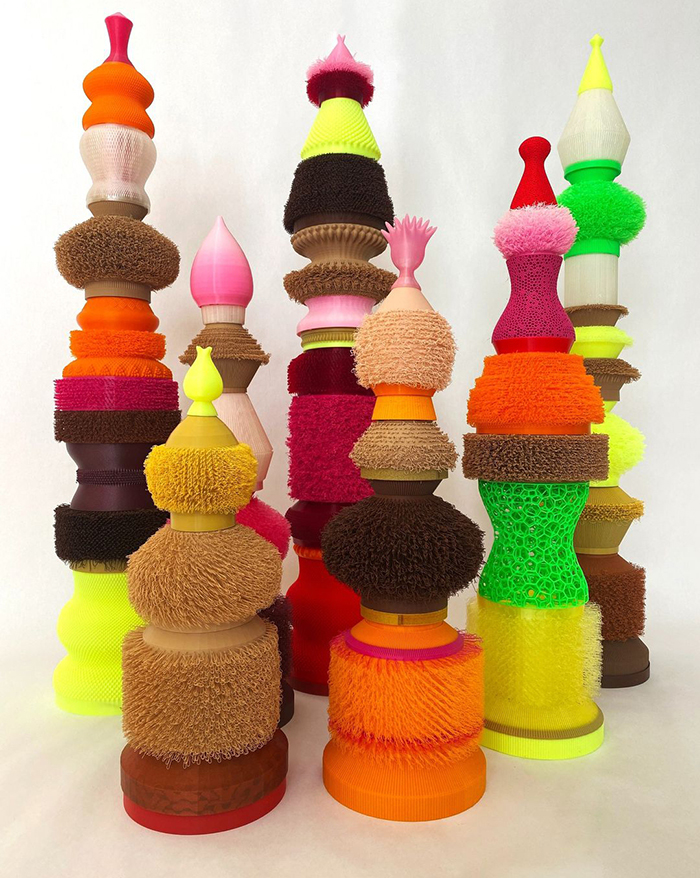
La tecnología evoluciona a pasos grandes y en el mundo del arte, la arquitectura y el diseño; la impresión 3D ha revolucionado estos campos creativos al ofrecer una manera versátil y novedosa para la materialización de ideas donde se unen la máquina y la inventiva poética humana. Esto lo sabe la arquitecta, diseñadora y educadora Virginia San Fratello quien junto a su socio Ronald Rael, fundaron Emerging Objects, una empresa pionera en diseño e investigación que se especializa en materiales y objetos impresos en 3D.
Technology is evolving by leaps and bounds, and in the world of art, architecture, and design, 3D printing has revolutionized these creative fields by offering a versatile and novel way to materialize ideas, where machine and human poetic ingenuity come together. This is known by architect, designer, and educator Virginia San Fratello, who along with her partner Ronald Rael, founded Emerging Objects, a pioneering design and research company specializing in materials and objects printed in 3D.
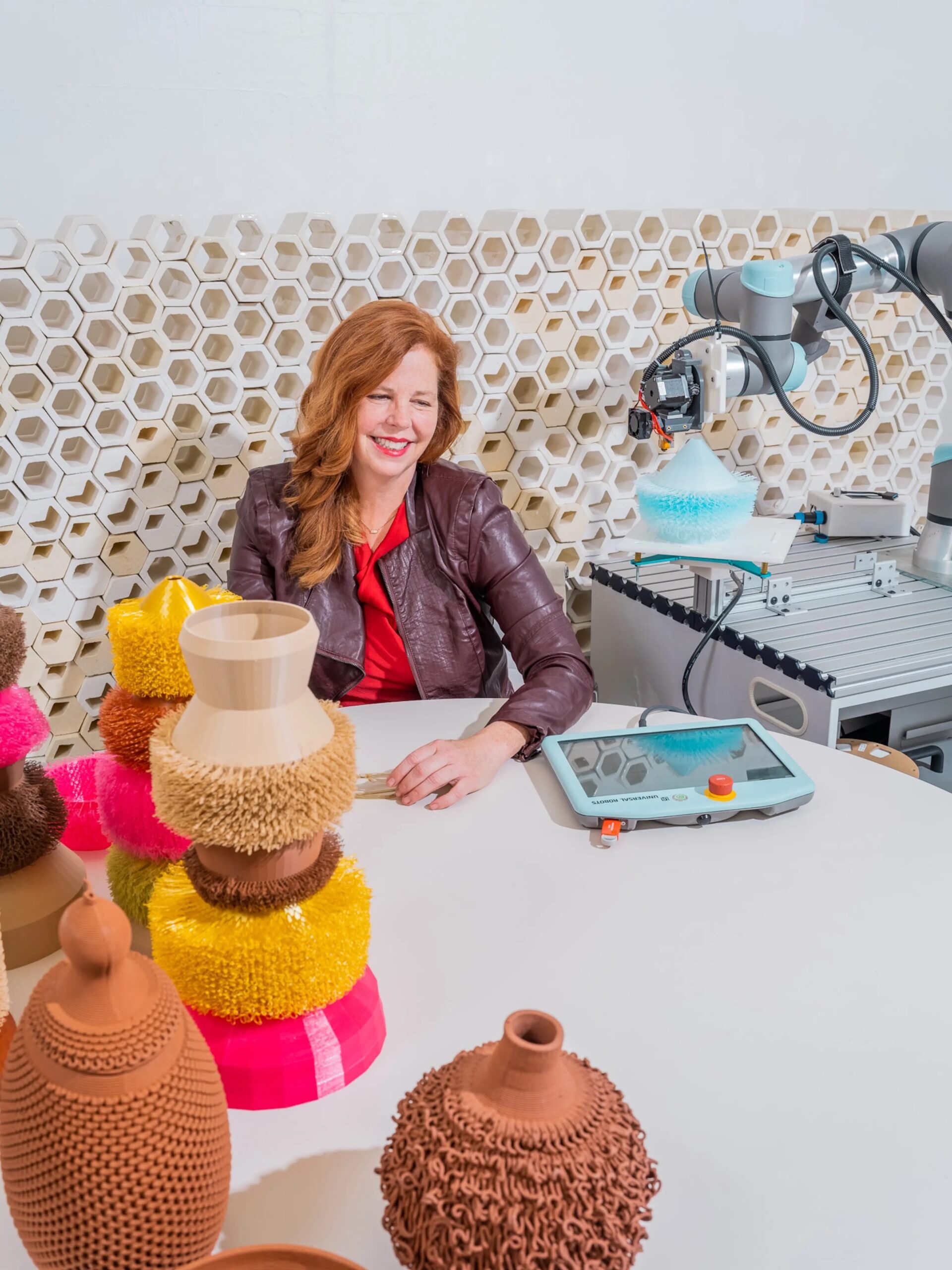
«Creo que es esencial que los diseñadores reflexionen profundamente sobre el ciclo de vida de los materiales que están utilizando». – Virginia San Fratello
«I believe it is essential for designers to deeply reflect on the life cycle of the materials they are using.» – Virginia San Fratello
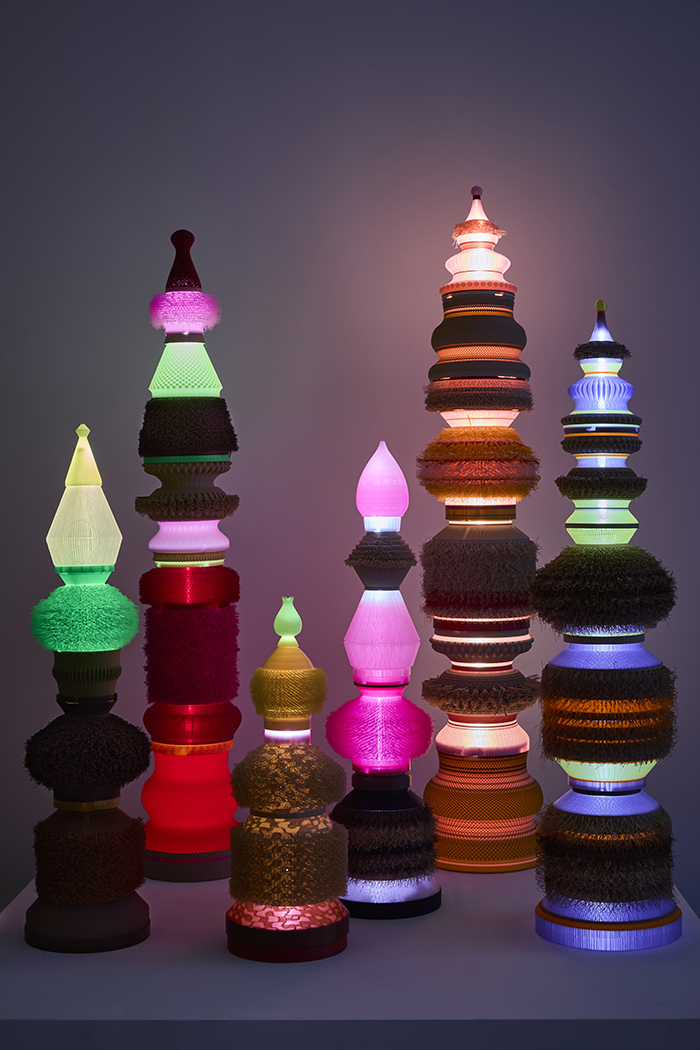
En esta ocasión, la diseñadora presenta su colección de lámparas Tótem, que ostentan texturas “peludas” impresas en 3D con bio-plástico de colores vibrantes y madera de color brillante, lo que las vuelve increíblemente atractivas a la vista. Además, son piezas elaboradas con madera reciclada en forma de aserrín, desperdicios de embalaje de alimentos reciclados y algunos residuos agrícolas como las semillas de granada.
On this occasion, the designer presents her collection of lamps boasting “furry” textures 3D-printed with vibrant-colored bio-plastic and bright-colored wood, making them incredibly visually appealing. Additionally, these are pieces crafted from recycled wood in the form of sawdust, recycled food packaging waste, and some agricultural residues such as pomegranate seeds.
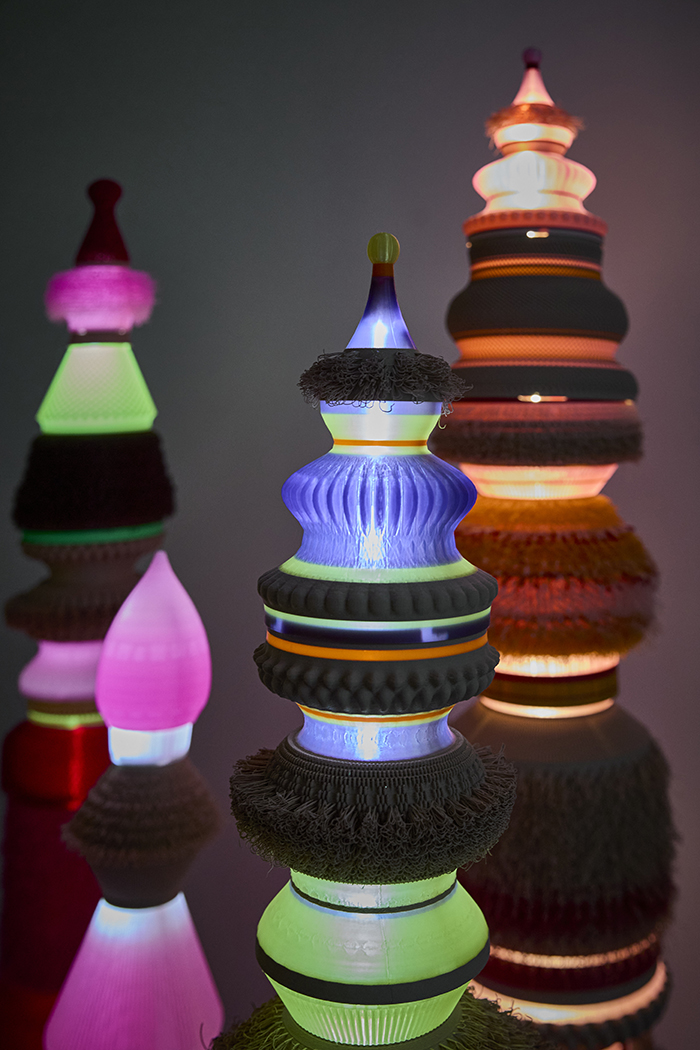

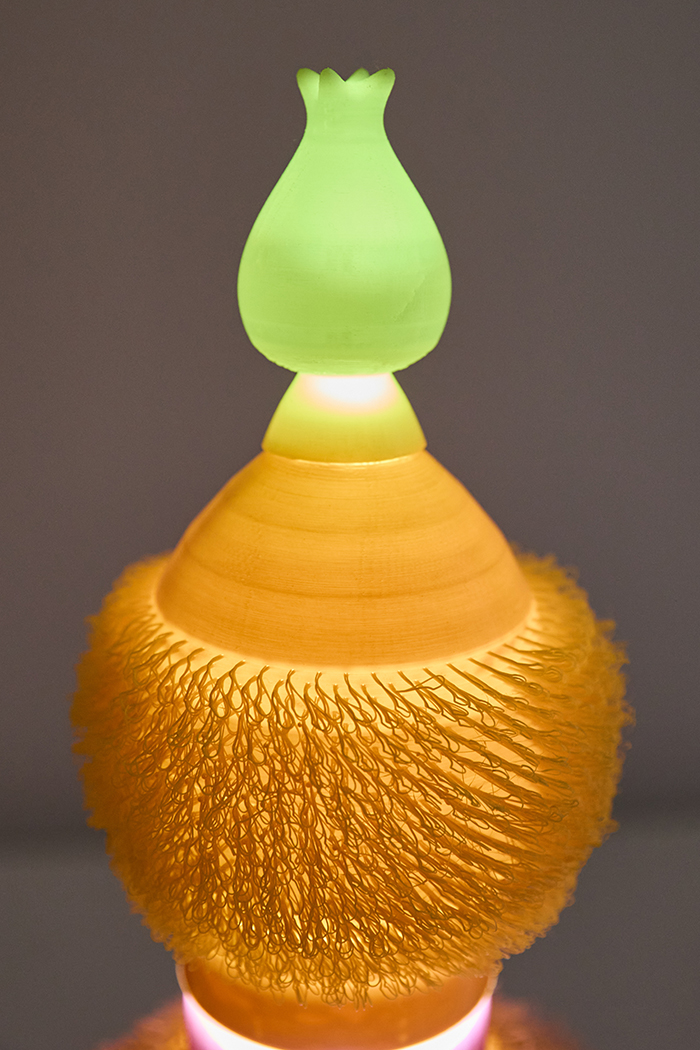
Las coloridas lámparas de Rael San Fratello, están hechas para producir sensaciones de calidez, confort y felicidad, donde destacan sus simpáticos nombres de las piezas que van desde “My SugarPuff Love”, hasta “Blood of My Enemies. Las lámparas estuvieron presentes durante la edición 19 de Design Miami en diciembre de 2023, en la Cristina Grajales Gallery, también aparecieron en la revista Modern Luxury, y parte de la colección especial “Where We Stand” de Design Miami fue incluida en “12 Things From Design Miami That We’re Totally Obsessed With” de Elle Decor.
Rael San Fratello’s colorful lamps are designed to evoke feelings of warmth, comfort, and happiness, highlighted by their playful piece names ranging from “My SugarPuff Love” to “Blood of My Enemies.” The lamps were showcased during the 19th edition of Design Miami in December 2023 at the Cristina Grajales Gallery. They also appeared in Modern Luxury magazine, and a portion of the special collection “Where We Stand” from Design Miami was featured in Elle Decor’s “12 Things from Design Miami That We’re Totally Obsessed With.”
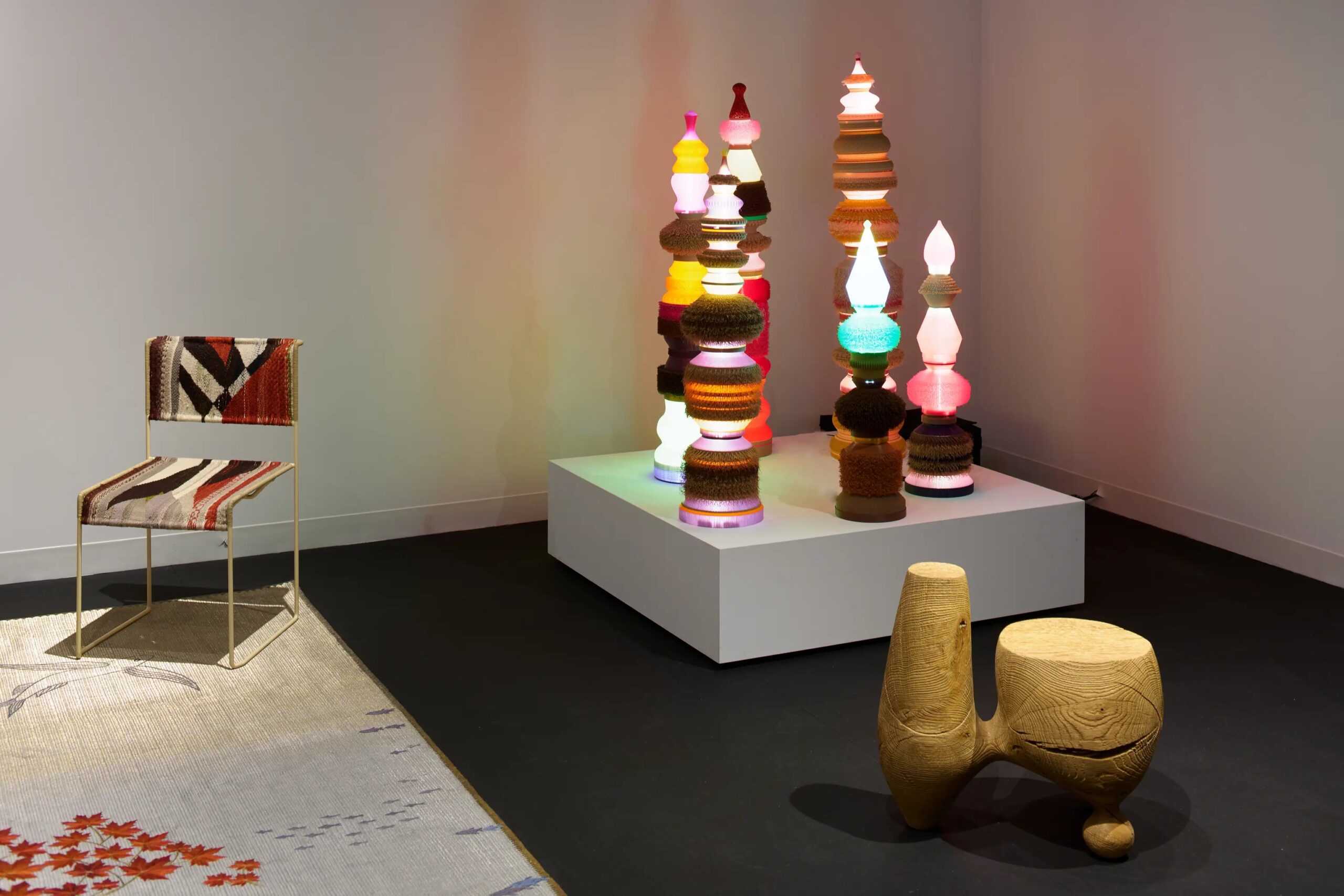
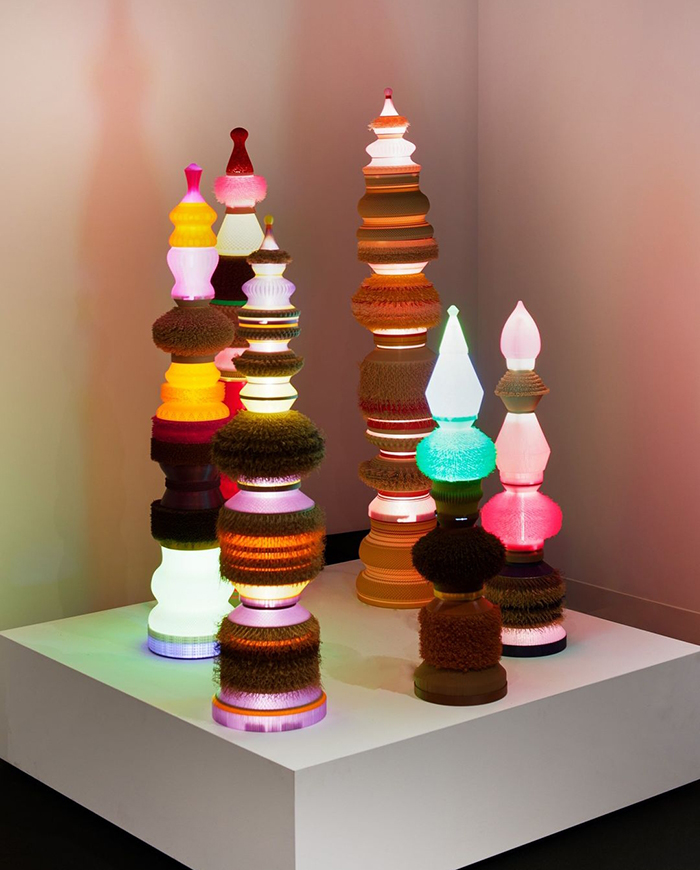
EXCLAMA se comunicó con la diseñadora y pudimos preguntarle sobre los procesos de producción y los materiales en este proyecto:
¿Cuál es la importancia de materiales como el bioplástico y los residuos reciclados en este proyecto?
Los tótems están hechos de residuos de envases de alimentos reciclados convertidos en un biopolímero para impresión 3D. Creo que es importante que nosotros, como sociedad, reconozcamos que los materiales de desecho, incluidos los plásticos reciclados, tienen el potencial de convertirse en materiales de construcción reales para el siglo XXI. Tenemos un exceso de estos materiales, se necesita mucha energía para descomponerlos en instalaciones de compostaje, y en la naturaleza, podrían tardar cien años, si no mil años, en descomponerse. A veces, estos plásticos se descomponen sustancialmente, pero luego terminan en el océano como partículas de microplástico y, debido a que el océano no tiene los microorganismos adecuados para compostar los plásticos, terminamos con residuos plásticos en nuestros océanos y en la vida marina. En última instancia, estos microplásticos terminan en nosotros, nos estamos convirtiendo en plástico. Desde 2020, se han descubierto plásticos en el cuerpo humano por primera vez y estamos listos para duplicar la producción de plástico para 2040, lo cual es preocupante. ¿Por qué no reducir la cantidad de plástico nuevo que se introduce en el mundo y reciclar el plástico existente? Los tótems están hechos de bioplástico y reciclado antes de convertirse en un material de desecho. Para mí, los residuos de plástico son un nuevo material vernáculo para el siglo XXI, uno que puede usarse para crear objetos funcionales y hermosos que mejoren nuestras vidas.
EXCLAMA contacted the designer, and we were able to ask her about the production processes and materials in this project:
What is the importance of materials like bio-plastic and recycled waste in this project?
The Totems are made of recycled food packaging waste converted into a bio filament for 3D printing. I think it is important that society acknowledge that waste materials, including recycled plastics, have the potential to become actual building materials for the 21st century. We have an overabundance of these materials, it takes a lot of energy to decompose them in composing facilities, and in nature, it might take one hundred years if not one thousand years to break them down. Sometimes, these plastics are substantially decomposed, but then end up in the ocean as microplastic particles and because the ocean does not have the right microorganisms to compost the plastics we end up with plastic waste in our oceans and in sea life. Ultimately, these microplastics end up in us, we are becoming plastic. Since 2020 plastics have been discovered in the human body for the first time and we are set to double plastic production by 2040, which is concerning. Why not reduce the amount of new plastic that is put into the world, and recycled the existing plastic? The totems are made of bioplastic and recycled before it becomes a waste material. For me, plastic waste is a new vernacular material for the 21st century, one that can be used to create functional and beautiful objects that enhance our lives.
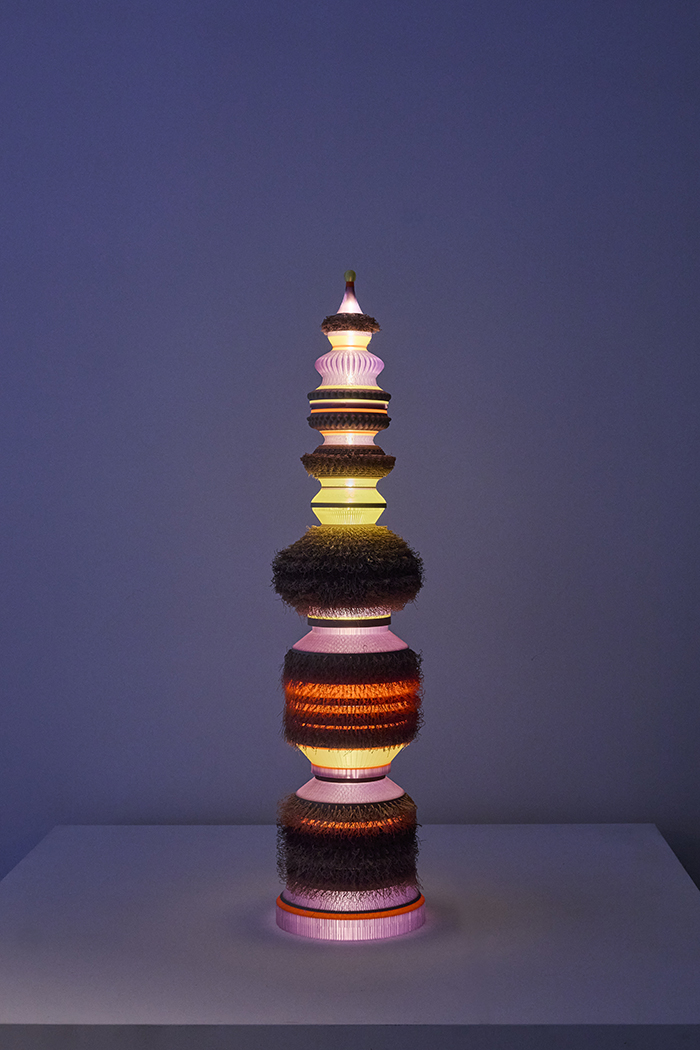
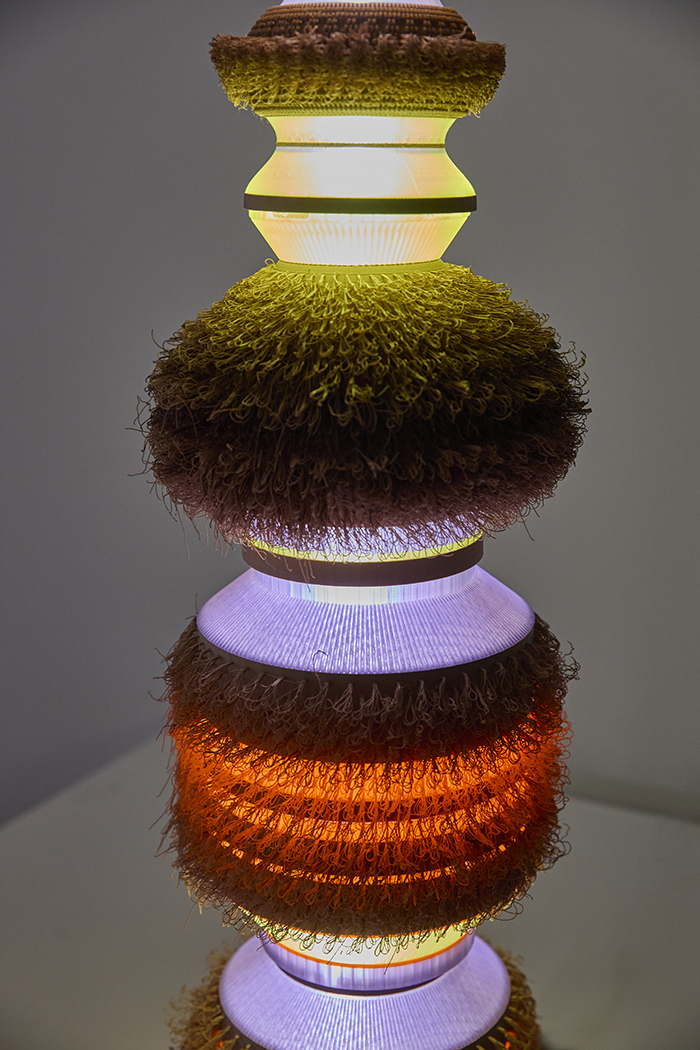
¿Cómo visualizas el papel de los materiales sostenibles para el diseño actual?
Creo que es esencial que los diseñadores reflexionen profundamente sobre el ciclo de vida de los materiales que están utilizando y especificando. La Tierra tiene recursos finitos y ya podemos ver los efectos de la industrialización en el cambio climático en todo el mundo. Cuanto más podamos usar materiales de bajo consumo energético, materiales locales, materiales renovables y reciclables, mejor será nuestra oportunidad de prolongar nuestra presencia en este planeta.
How do you visualize the role of sustainable materials for the present of design?
I think it is essential that designers think deeply about the lifecycle of the materials that they are using and specifying. The earth has finite resources, and we can already see the effects of industrialization on climate change around the world. The more we can use low-energy materials, local materials, renewable materials, and recyclables the better chance we have of extending our presence on this planet.
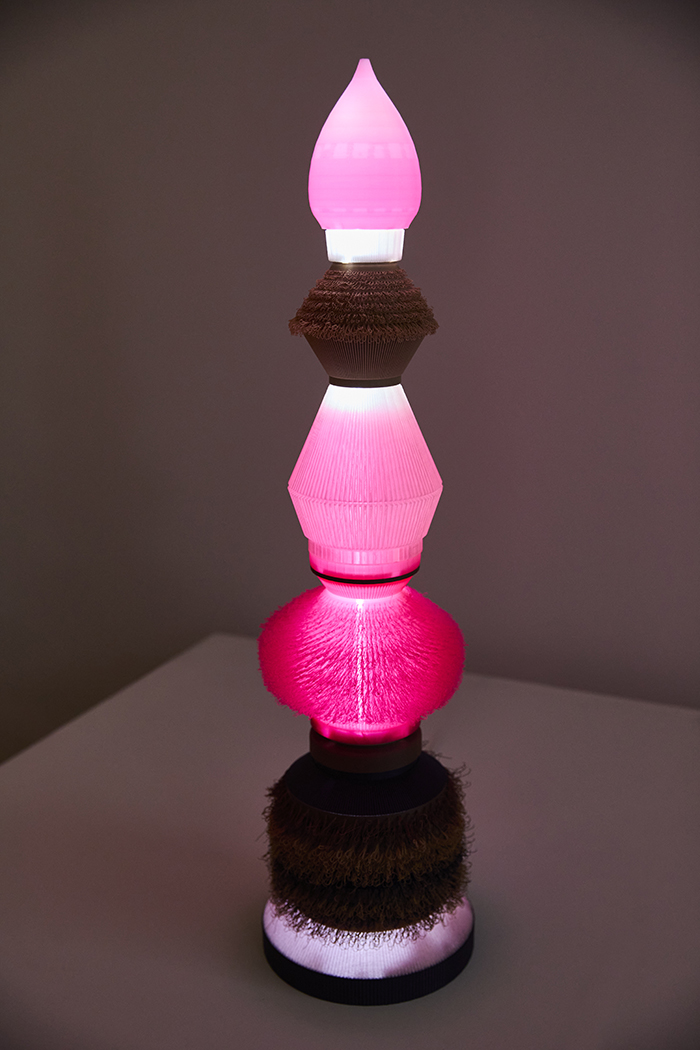
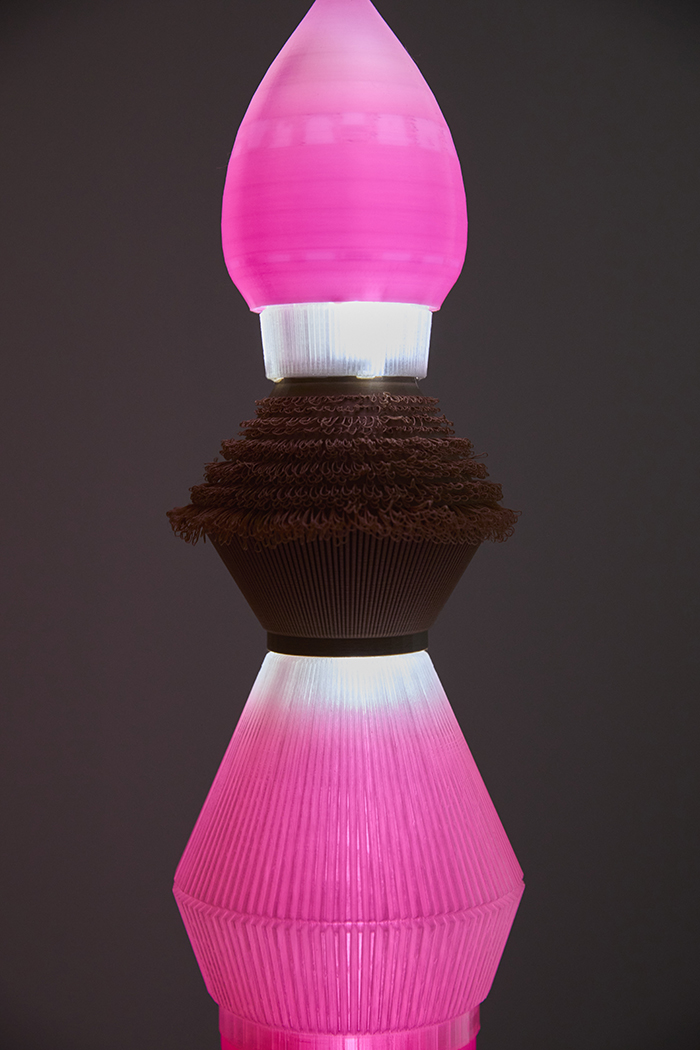
¿Podrías describir tu proceso creativo al desarrollar tus diseños?
Al desarrollar un nuevo diseño, suelo comenzar pensando en los materiales que estoy utilizando y en el proceso de fabricación, especialmente cómo podría explorar alguna nueva propiedad de material o una nueva forma de utilizar mis herramientas en el proceso de creación. Para los Tótems de Luz Peludos, estaba emocionado por experimentar con el puenteado en la impresión 3D. Puenteado es un término que se refiere a un plástico que necesita ser extruido entre dos puntos sin ningún soporte desde abajo. Para crear la textura peluda, mis puentes generalmente pueden ser impresos sin ningún soporte, lo que ahorra material y tiempo de impresión y, por supuesto, crea la textura peluda única en los tótems. Estoy utilizando de manera incorrecta una operación en la impresora 3D, y está creando algo nuevo y diferente que normalmente no esperamos ver de esta tecnología. Debido a que la impresión 3D todavía está en pañales, creo que es importante que los diseñadores y artistas utilicen las máquinas de formas experimentales, que es lo que intento hacer no solo cuando «abuso» de la impresora, sino también cuando coloco mis propios materiales en la impresora.
Could you describe your creative process when developing your designs?
When developing a new design, I often like to start by thinking about the materials that I am using and the fabrication process, particularly how I might tease out some new material property or new way of using my tools in the creation process. For the Furry Light Totems, I was excited to experiment with bridging in 3D printing. Bridging is a term that refers to a plastic that needs to be extruded between two points without any support from below. To create the fury, my bridges can typically be printed without any support which saves material and print time and of course creates the very unique furry texture on the totems. I’m misusing an operation in the 3D printer and it’s creating something new and different that we don’t normally expect to see from this technology. Because 3D printing is still in it’s infancy, I think it is important that designers and artists use the machines in experimental ways, which is what I try to do not only when I «misuse» the printer, but also when I put my own materials in the printer.
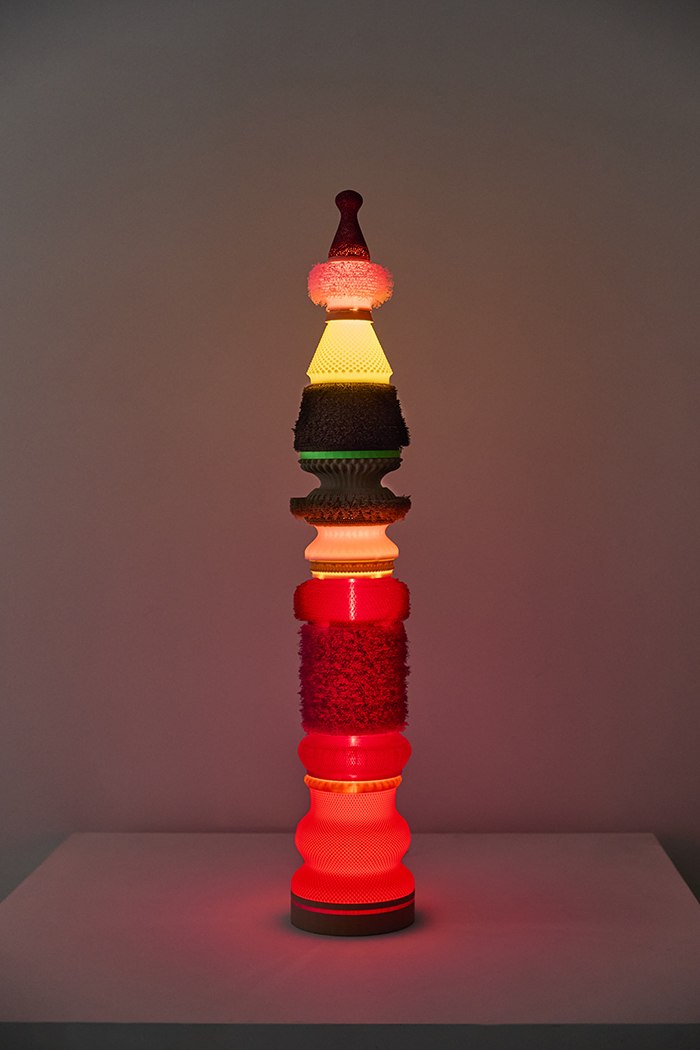
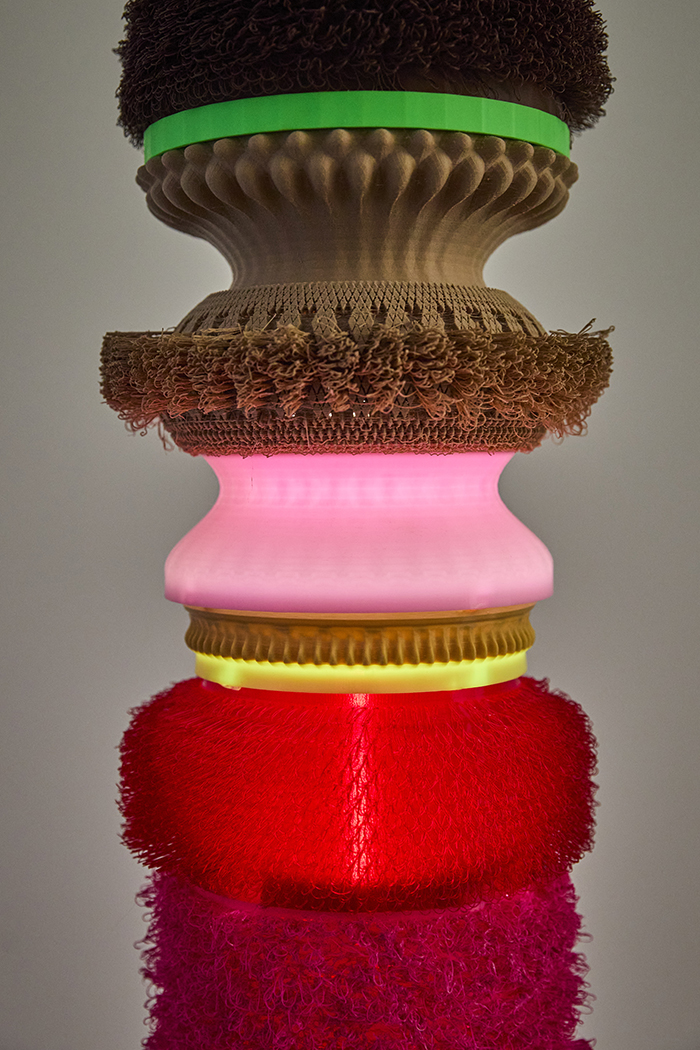
¿Crees que los diseñadores deberían utilizar la inteligencia artificial en todas las disciplinas del diseño ahora?
Creo que la inteligencia artificial es una herramienta poderosa de la que los diseñadores pueden aprovecharse, pero no creo que todos tengan que usarla. Es solo otra herramienta, y es responsabilidad del diseñador decidir cuándo la inteligencia artificial es la mejor herramienta para usar. ¡A veces un simple boceto a lápiz es mejor! Solo depende de lo que estés creando, lo que te inspire y qué herramientas sean óptimas para crear el resultado final.
You believe that designers should use AI across all design disciplines now?
I believe that AI is a powerful tool that designers can take advantage of, but I don’t believe that everyone must use it. It’s just another tool and it is the responsibility of the designer to decide when AI is the best tool to use. Sometimes a handmade pencil sketch is better! It just depends on what you are making, what inspires you and what tools are optimal for creating the result.

